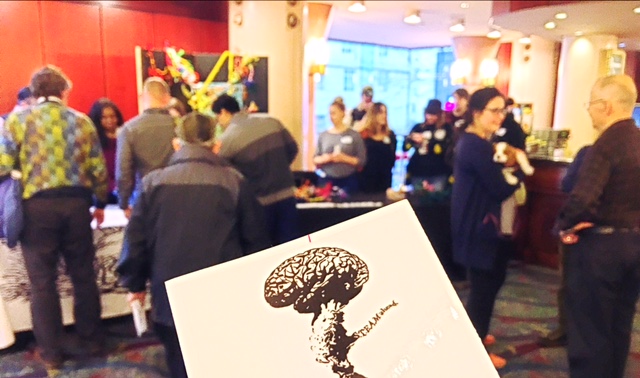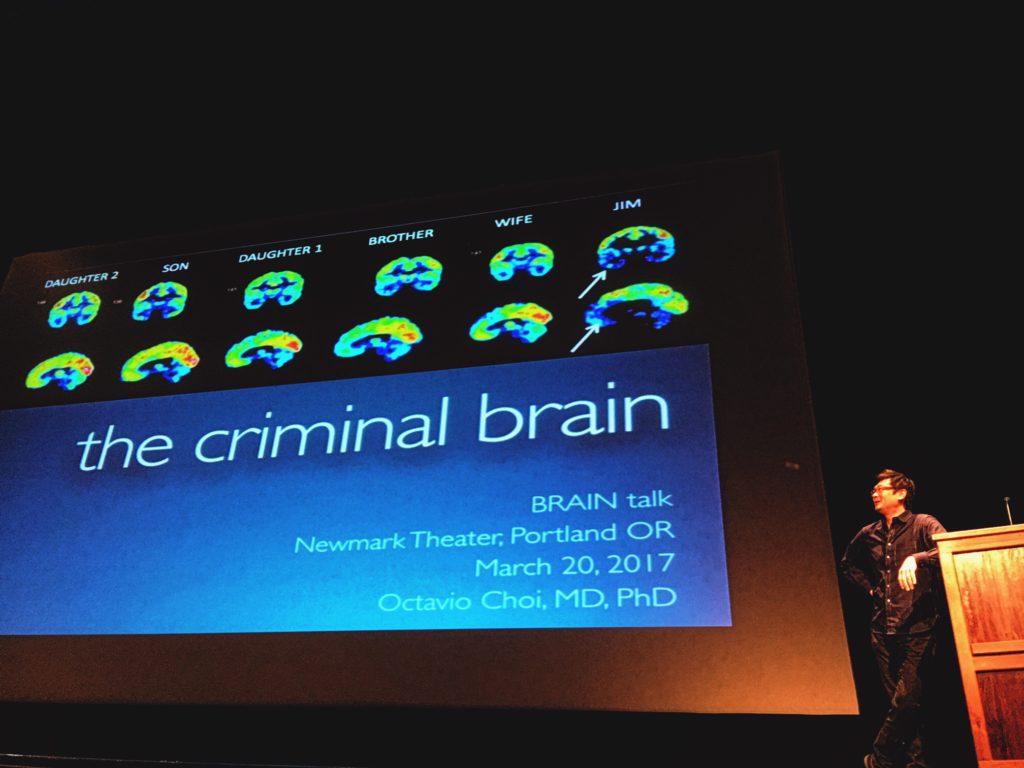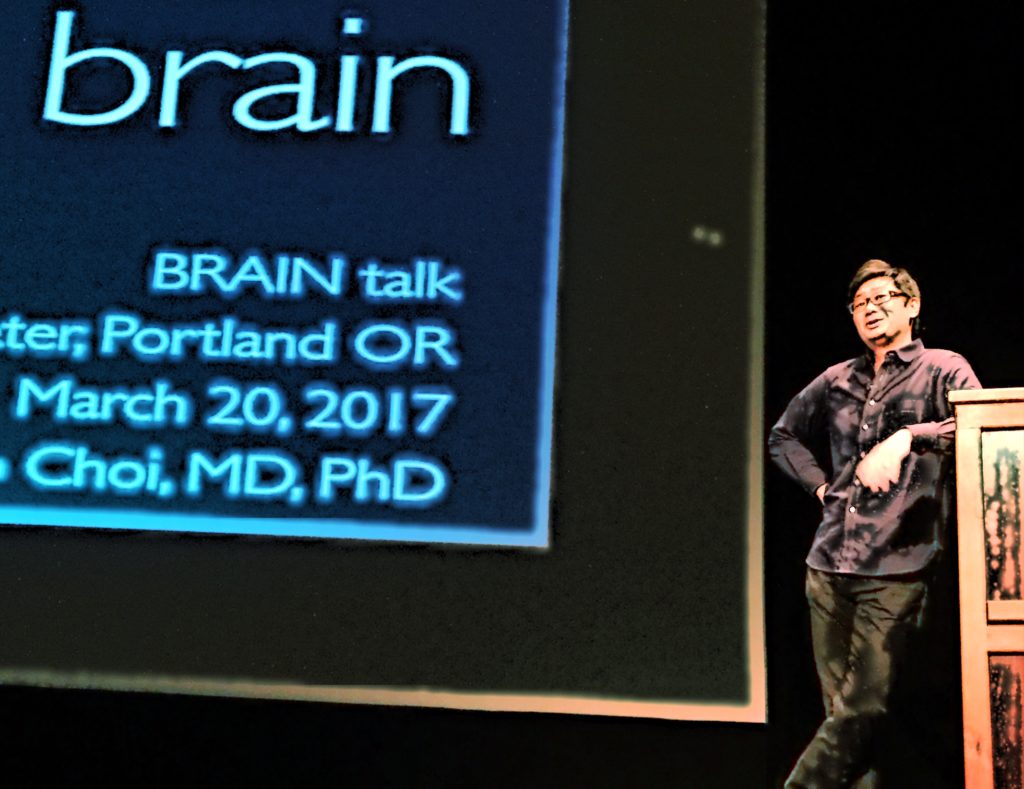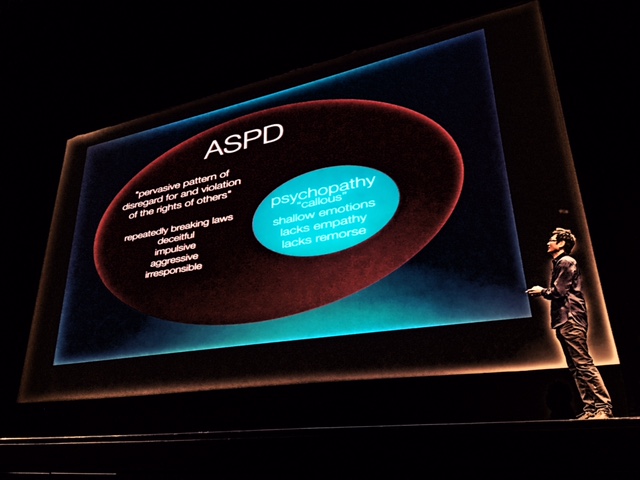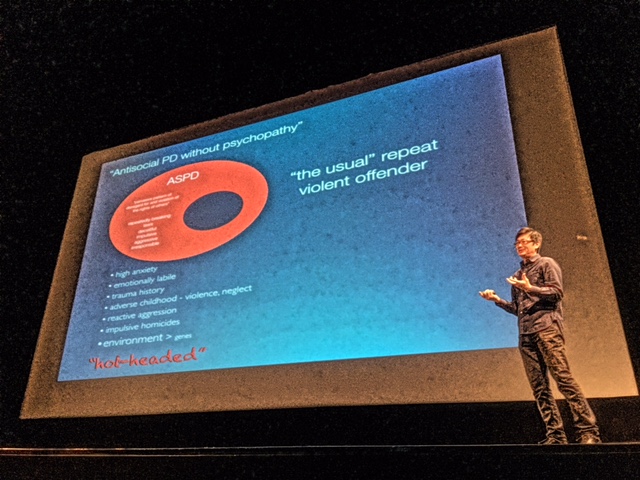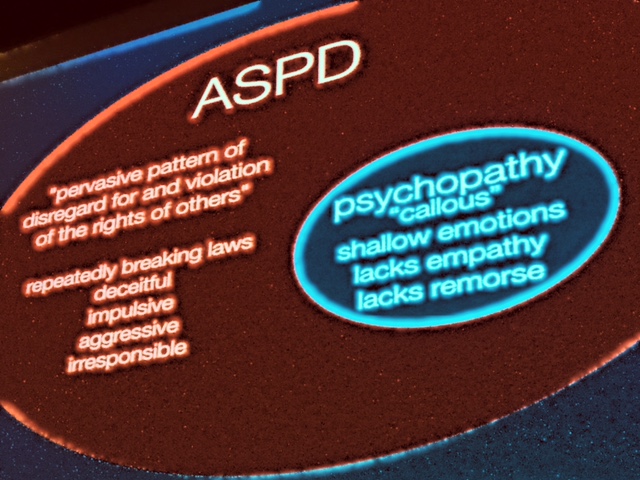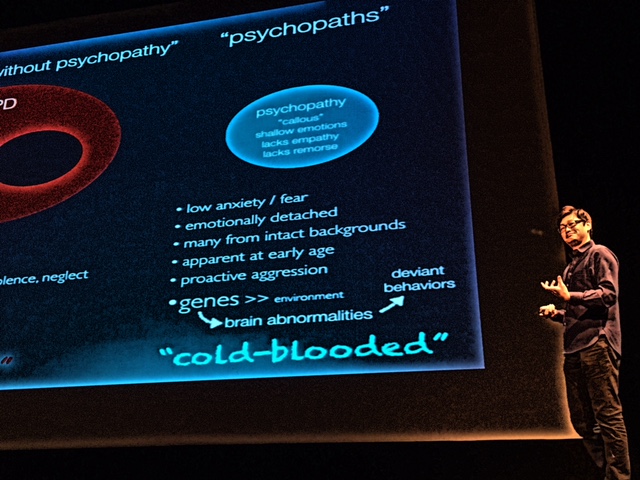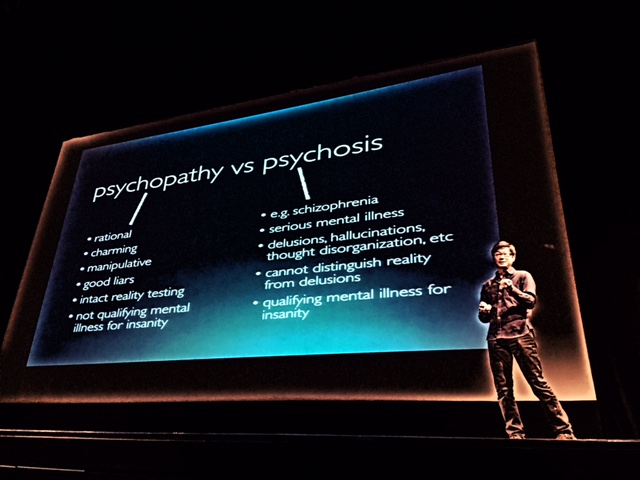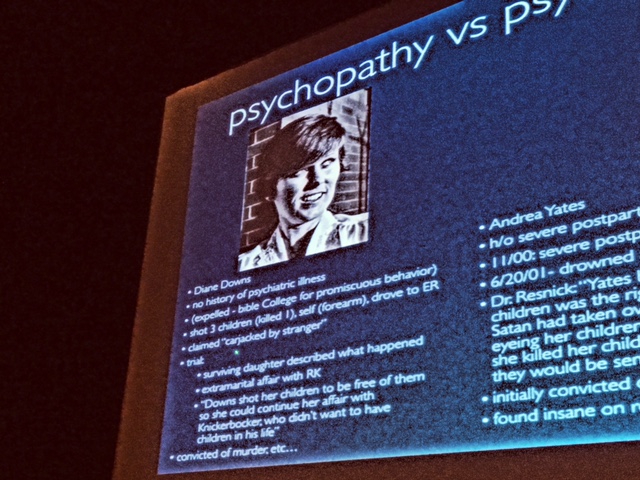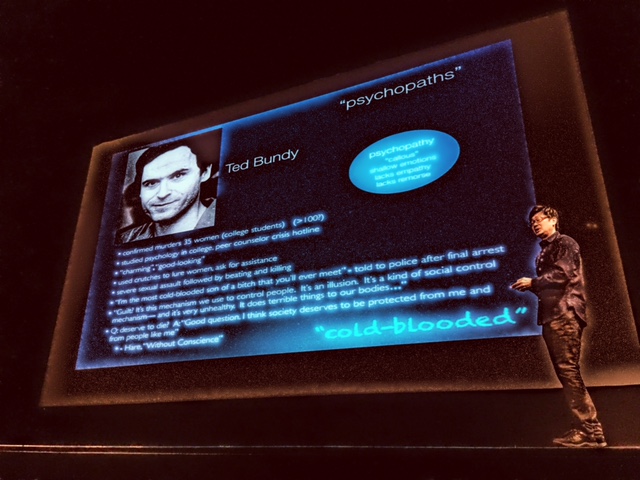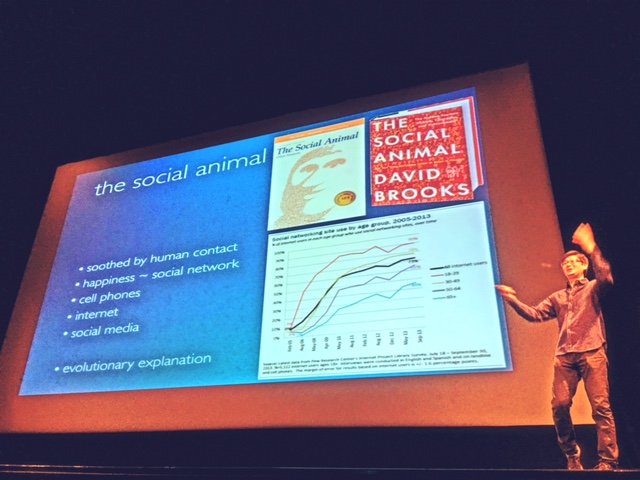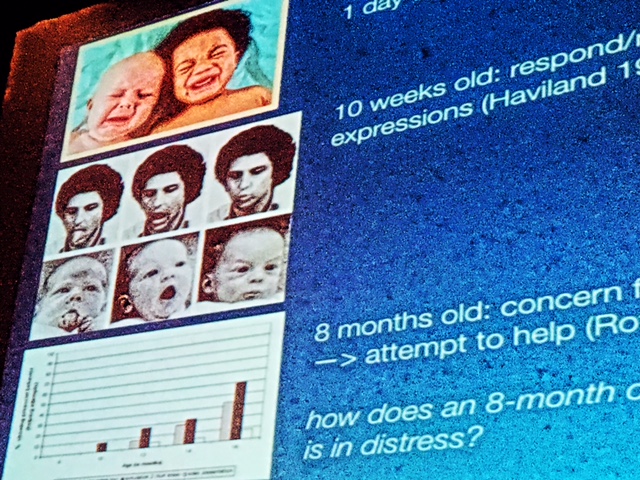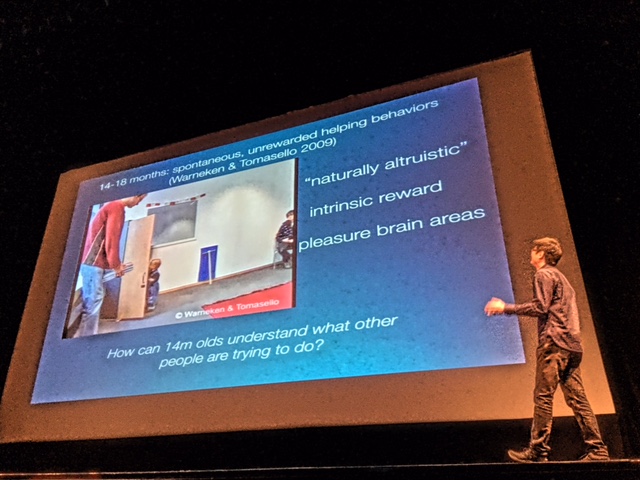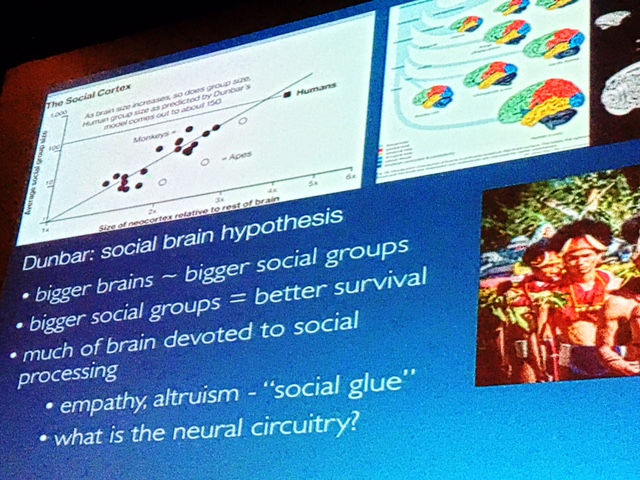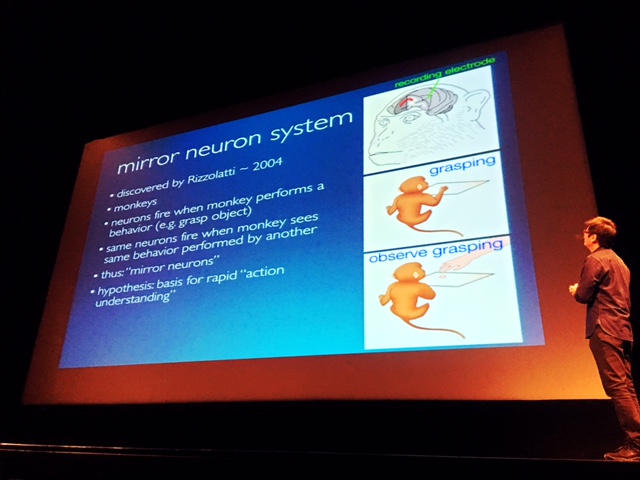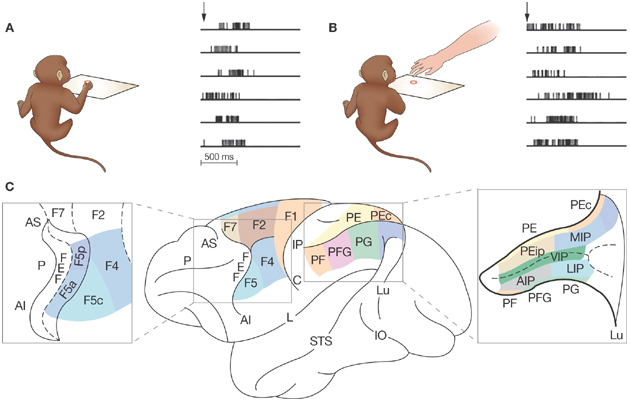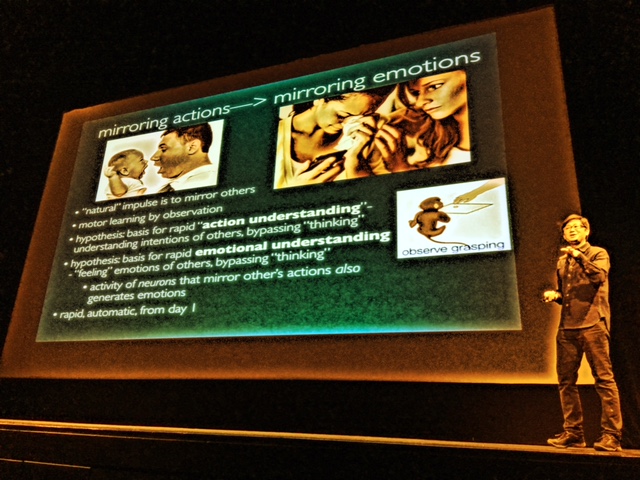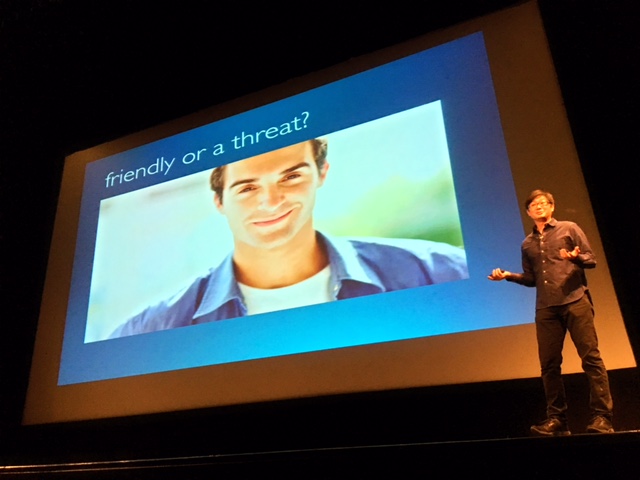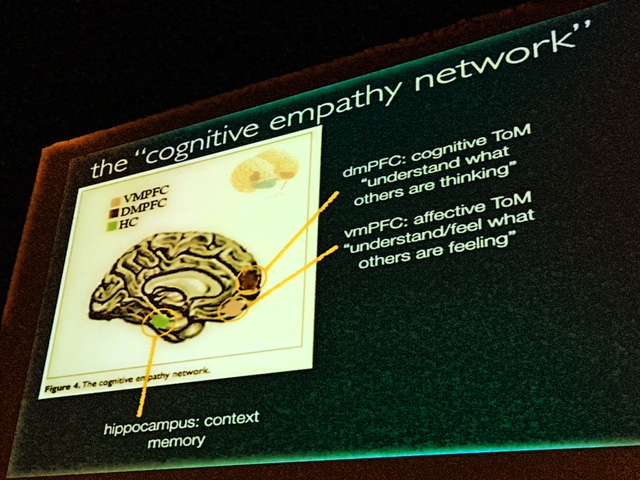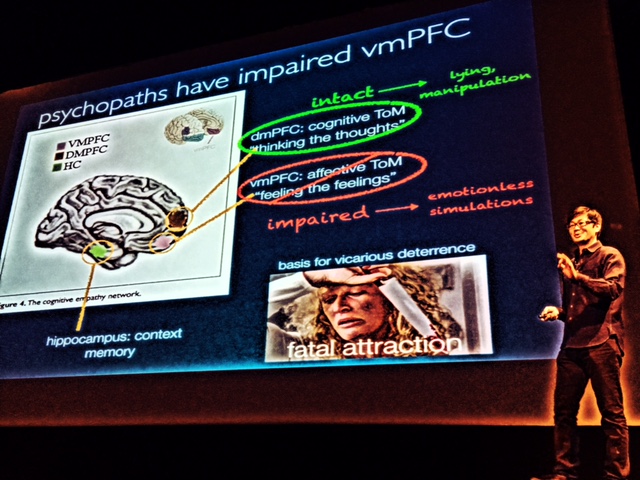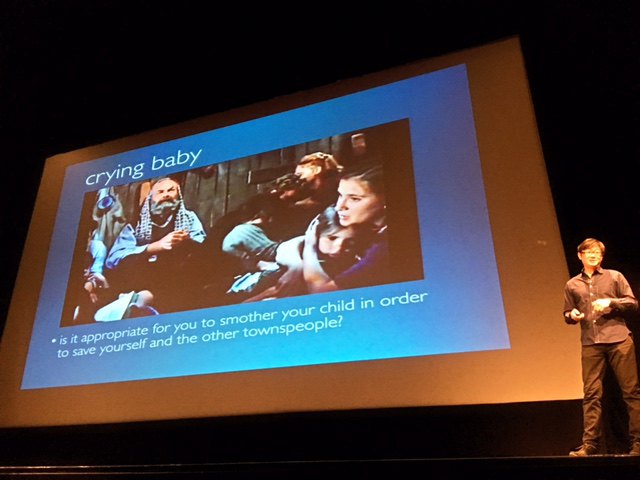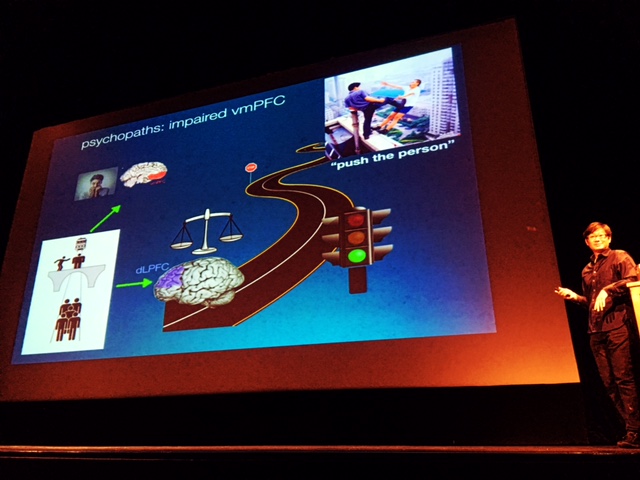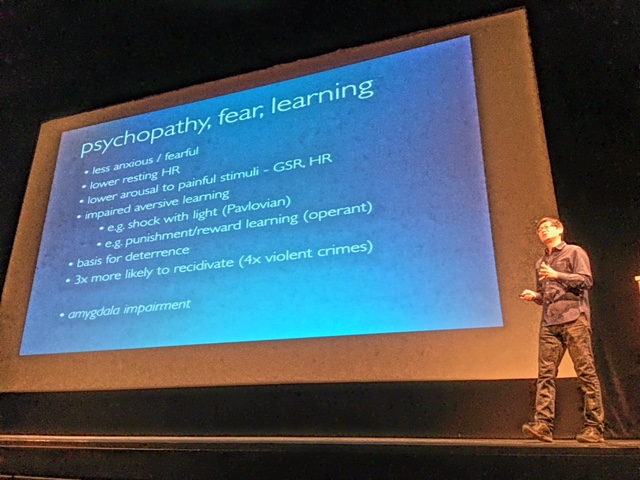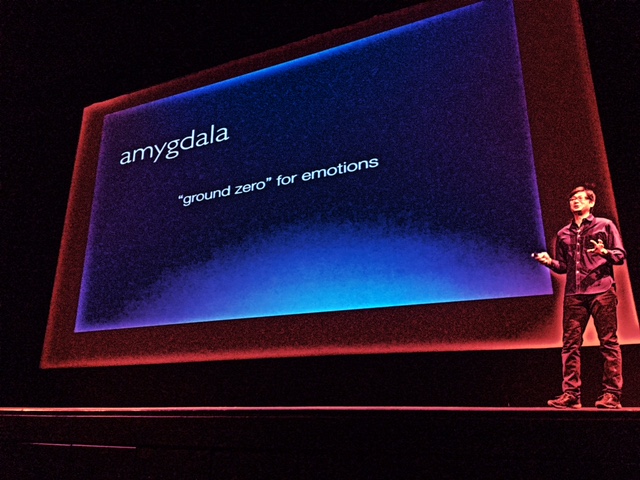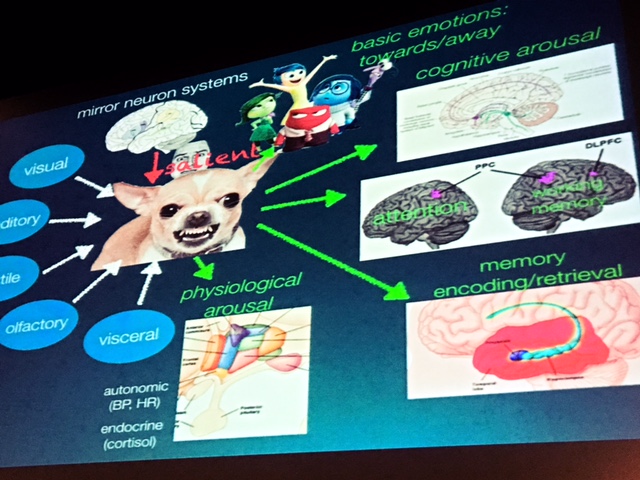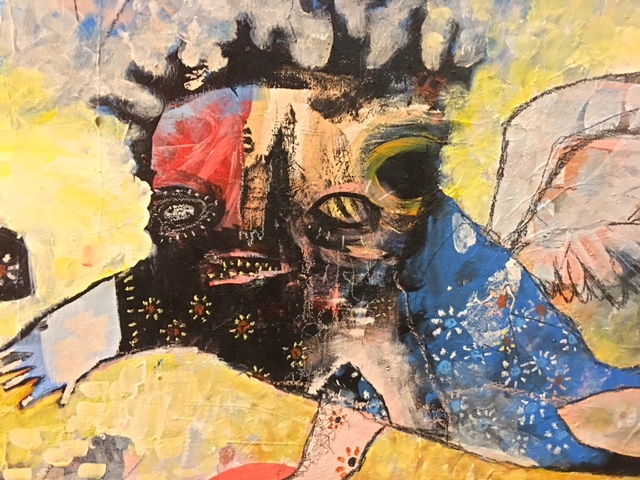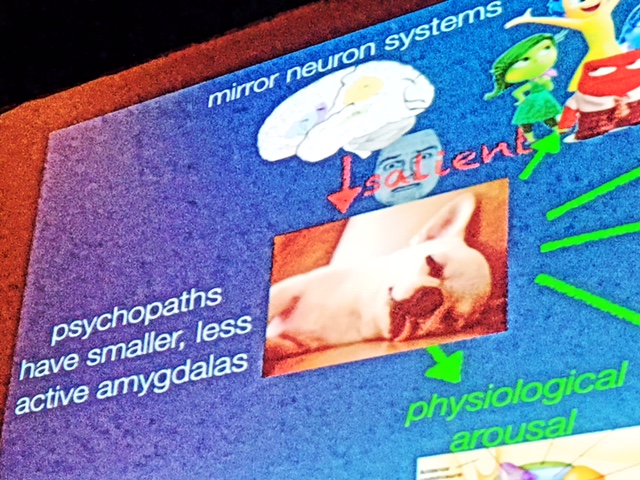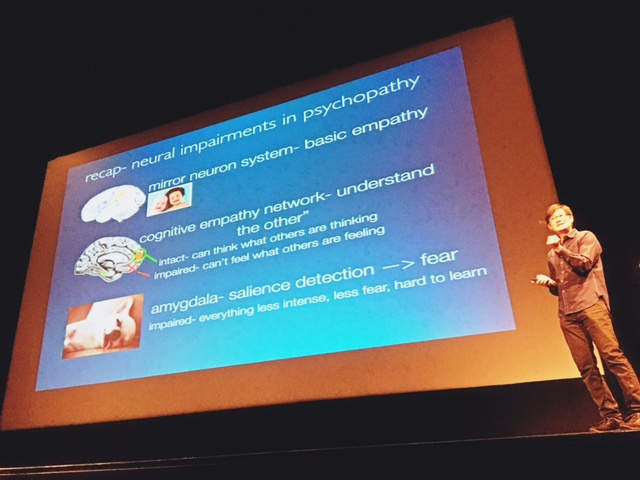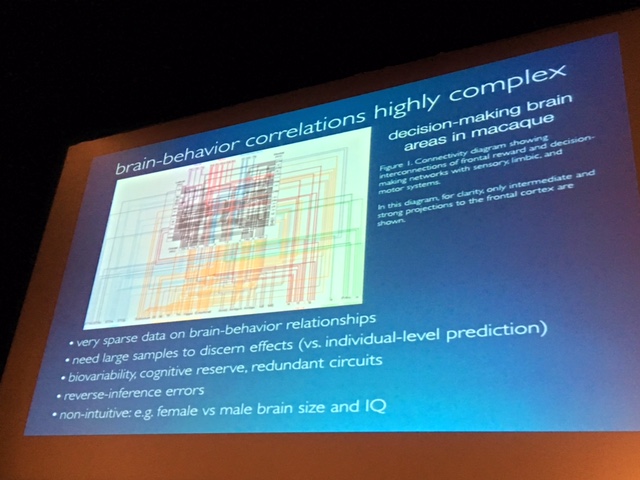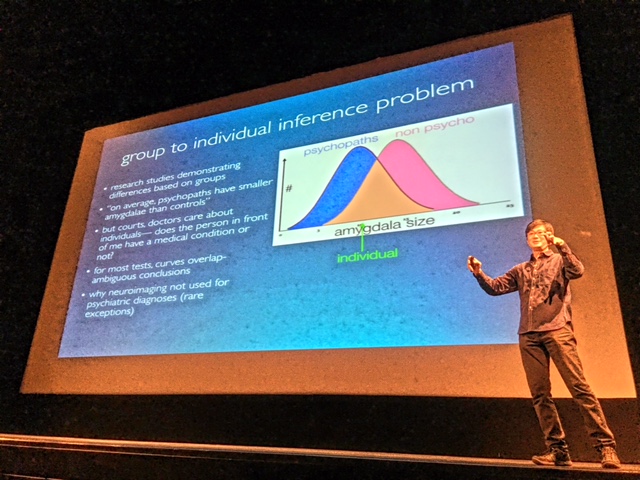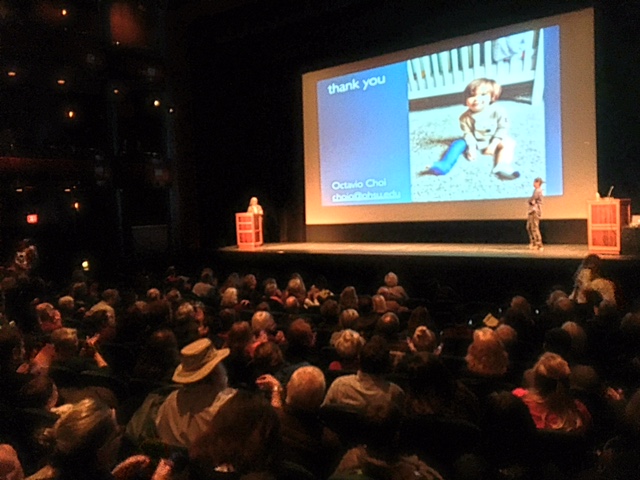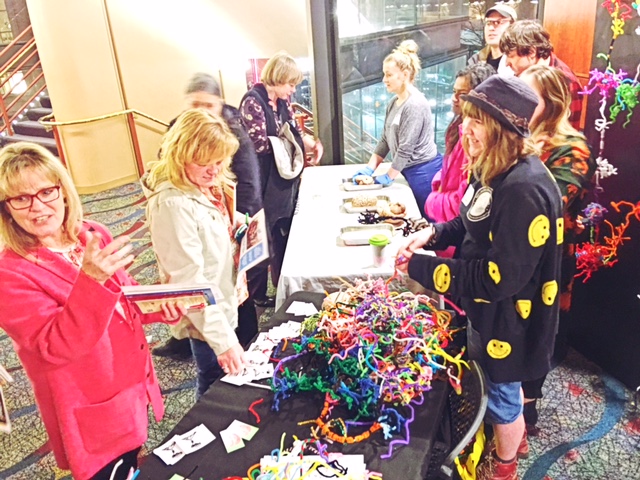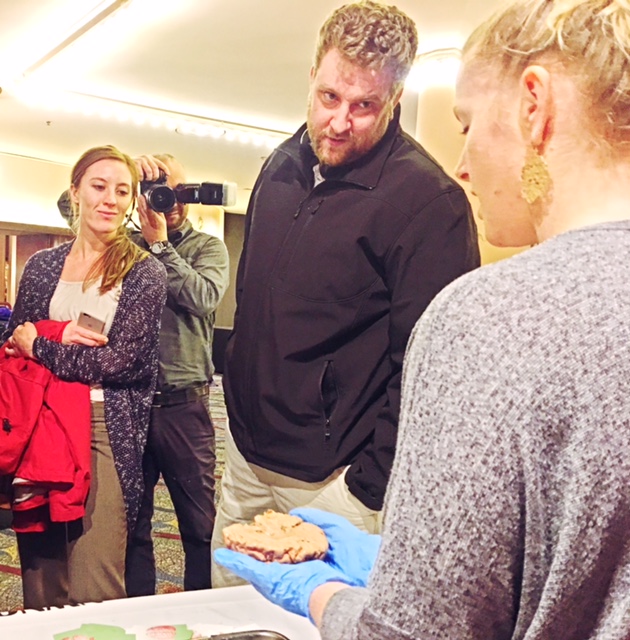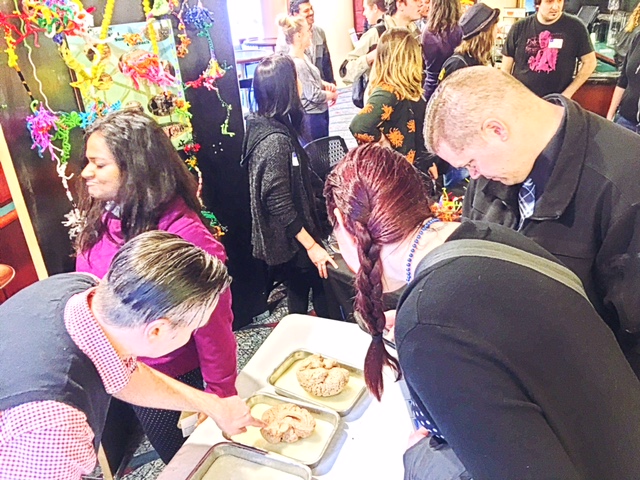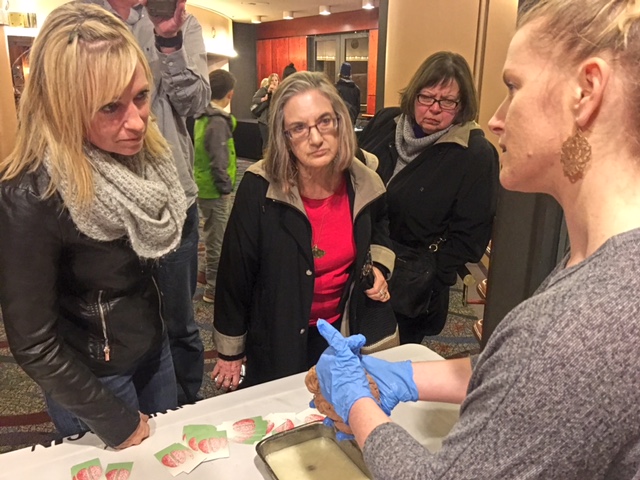What is a psychopath? What drives a Ted Bundy, or a Diane Downs, to be so cold blooded – and to lie, manipulate, and commit horrific crimes without experiencing remorse? Do the brains of psychopaths differ? Can we identify changes in specific brain regions that might predict or diagnose this condition? How should efforts to understand the biological basis of psychopathy affect law enforcement, and the courts?
Thanks to Kate Stout of the OHSU Brain Institute, we brought ten terrific NW Noggin volunteers to help kick off the 17th year of Brain Awareness lectures at the Newmark Theater in downtown Portland this week. Jessica Patching-Bunch, Thomas Madison, Austin Abshire, Ankita Guchait, Kayla Stippich, Brit Gratreak, Aliese Poole, Annalicia Whittaker and Kayla Townsley from PSU Psychology, and Angela Gonzalez of WSUV Neuroscience discussed brains and brain research, education and outreach with Newmark attendees before the show…
We were there to learn about psychopathy from noted expert Octavio Choi, an Assistant Professor in the Public Psychiatry Division of Oregon Health & Science University, and the Director of the Forensic Evaluation Service at the Oregon State Hospital in Salem…
LEARN MORE: The Oregon Health and Science University – Oregon State Hospital Collaboration
Dr. Choi had recently completed 28 weeks of silent mediation (in the Vipassana tradition), but he was vocal and entertaining on stage! He began by asking us to look around at our neighbors, noting that one out of every hundred individuals are estimated to be psychopaths, “so there are probably three or four of you sitting in this room tonight!”
LEARN MORE: Epidemiology, Comorbidity, and Behavioral Genetics of ASPD and Psychopathy
Dr. Choi then offered exactly what our volunteers love to hear – an in-depth examination of the structural and functional neuroanatomy underlying behavior. In this case the behavior is profoundly disturbing, exhibited by individuals with shallow emotional responses, and a notable lack of empathy for other human beings…
When many think about criminal anti-social behavior, suggested Dr. Choi, they imagine people who are impulsive, irresponsible and aggressive, who repeatedly break laws, and who exhibit a “pervasive pattern of disregard for and violation of the rights of others.” They also think of “hot-headed” criminals…
Such individuals have often suffered serious trauma, violence and neglect, and can be anxious and reactive…
LEARN MORE: Antisocial Personality Disorder
However a subset of those with ASPD are unusually callous, with shallow emotional responses, and often an utter absence of remorse or empathy for their victims. These “psychopathic” individuals may have had intact households as children, but from early on exhibited emotional detachment and “cold-blooded” behavior…
LEARN MORE: The criminal psychopath: History, neuroscience, treatment, economics
LEARN MORE: The antisocial brain: psychopathy matters
Dr. Choi often testifies at jury trials on the neuroscience of psychosis and psychopathy, and explained that “psychotic” disorders are characterized by a difficulty distinguishing between delusions and reality. He cited the case of Andrea Yates, who drowned her five children in a bathtub in 2001. According to forensic scientist Dr. Phillip Resnick, who testified at the trial, “Yates believed deeply that killing her children was the right thing to do. She believed that Satan had take over her body and soul, and was eyeing her children’s souls next…she believed that, if she killed her children while they were still innocent, they would be sent to heaven…”
LEARN MORE: Woman may face death penalty in postnatal depression case
LEARN MORE: Child murder by mothers: patterns and prevention
LEARN MORE: Filicide in the United States
Yates was highly delusional, and psychotic, and found not guilty by reason of insanity…
In contrast, psychopaths are often effective liars, something that takes significant cognitive effort and skill, so courts do not typically permit an insanity defense. Diane Downs, for example, shot three of her own children (killing one) in order to continue an affair with a man who did not want kids, and yet claimed to have been “carjacked by a stranger.”
Diane Downs was exceedingly cold-blooded; as Dr. Choi noted, “she tried to murder children in order to have a better dating life!”
LEARN MORE: State denies parole to child killer Downs
LEARN MORE: The Diane Downs Story
So what is going on in the brain of Diane Downs, Ted Bundy, and other psychopathic individuals, that might account for such cold-blooded and manipulative behavior..?
Dr. Choi focused on three regions of the brain where differences are found in both structure and function from an early age. These areas – including the ventromedial prefrontal cortex (vmPFC), amygdala, and the “mirror neuron system” in the inferior frontal gyrus (and elsewhere) – are critically involved in emotional response…
We are, he explained, exceptionally social creatures, driven to engage with others, and innately aware of emotional experiences practically at birth. At one day old, for example, babies will cry if they hear or see other babies crying. They’ll also mimic emotional expressions, typically from ten weeks on…
LEARN MORE: Contagious crying beyond the first days of life
LEARN MORE: Does the Organization of Emotional Expression Change Over Time? Facial Expressivity From 4 to 12 Months
Most of us are also intrinsically altruistic, and appear to understand and empathize with the basic needs of others, again beginning in early childhood…
LEARN MORE: Varieties of altruism in children and chimpanzees
LEARN MORE: Beneficial effects of human altruism
Dr. Choi also noted that big brains are associated with greater social engagement, and cited Robin Dunbar’s “social brain hypothesis,” which suggests that based on brain size, humans can form around 150 strong social connections. How many of us, he asked, use social media, and cellphones?
LEARN MORE: The Social Brain Hypothesis
LEARN MORE: The social brain hypothesis and its implications for social evolution
But how exactly do we have insight into the emotions, motivations and intentions of others, and from such an early age? Which brain networks process social stimuli, including facial expressions, adjustments in posture, reflexive responses, gestures, etc..?
Italian neuroscientist Giacomo Rizzolatti discovered how primates might gain direct insight into the actions of others through neurons that respond not only when an animal makes a specific movement themselves, but also when someone else makes that same movement…
IMAGE SOURCE: The upper part of the figure shows the activity of a mirror neuron recorded from area F5. The neuron fires when the monkey grasps an object (A) and when it observes the experimenter grasping the object…
These mirror neurons have been found in many areas of the brain, including regions like the insular cortex, where visceral and emotionally salient inputs from the body are initially mapped…
LEARN MORE: Neurophysiological mechanisms underlying the understanding and imitation of action
LEARN MORE: The mind’s mirror
LEARN MORE: Mirror neuron research: the past and the future
LEARN MORE: Mirror neurons and their clinical relevance
Mirror neuron responses might offer us rapid “affective” (emotional) resonance with others, and could form the basis for emotional contagion (e.g., crying babies making other babies cry, or the notorious spread of yawns). They are also, suggested Dr. Choi, a key component of empathy – “I can feel what you feel by mirroring your body,” he explained. “It’s a beautiful thing!”
The inferior frontal gyrus (IFG) in the lateral frontal lobe is one region where mirror neurons respond to emotional expressions – and more empathetic individuals have a thicker IFG…
LEARN MORE: The neural bases for empathy
Psychopaths, unsurprisingly, have thinner inferior frontal gyri. According to Dr. Choi, they also have “blunted” responses in mirror neurons in both insula and anterior cingulate cortex, areas critical for the felt experience of pain. Thus, “at a basic level of their wiring,” psychopaths don’t appear to appreciate the distress of others…
LEARN MORE: Cortical thinning in psychopathy
LEARN MORE: Neurobiology of Empathy and Callousness
In addition to brain areas that respond quickly to emotions expressed by others, and which offer fast insight, our brains also develop “models” of social behavior and social expectations, allowing us to cognitively consider, or “mentalize” situations, and play out various scenarios. The “magic of the brain,” Dr. Choi noted, is how we can recreate past experiences, in terms of what we saw, heard, smelled – and felt, viscerally – and also “run scenarios where you’re vividly living these experiences – you can project yourself into the past or future!”
Is this a smile from your husband, asked Dr. Choi, or a “shit-eating grin from your arch-nemesis at work..?”
Adults need to be able to assess situations cognitively, too, add context and memories, and play out various scenarios while feeling the potential consequences to help guide our complex social decisions. A baby can’t do this – it requires experience, and a history of social failures, successes and mistakes. Significant areas of the frontal lobes, networked with other regions (including the hippocampus, which is critical for memories to provide context) have to develop network coordination to effectively navigate our complex social world…
Research suggests that the ventromedial prefrontal cortex (vmPFC) is essential for developing an “affective theory of mind (ToM)” or as Dr. Choi put it, “understanding and feeling what others are feeling” in a particular social context. In contrast, the dorsomedial prefrontal cortex (dmPFC) contributes a “cognitive ToM,” letting you “understand what others are thinking…”
LEARN MORE: Segregation of the human medial prefrontal cortex in social cognition
LEARN MORE: Neural processing of dynamic emotional facial expressions in psychopaths
Interestingly, psychopaths may have relatively normal activity in their dmPFC – in other words, they know what you’re thinking, and can therefore cognitively appraise a situation and manipulate it effectively…
However they have impaired activity in the vmPFC, so they lack empathy for felt consequences for others. “Other people are robots” to a psychopath, said Dr. Choi. Another researcher, he told us, described it this way: “they know the words, but not the music.” According to Dr. Choi, the notorious “bunny” scene in the movie “Fatal Attraction” was so effective at deterring cheating by non-psychopathic spouses because we viscerally experience the gut-wrenching horror of that moment and want to avoid a related situation at all costs!
WATCH (if you can handle it): Boiled Bunny from Fatal Attraction
Moral judgments involving emotional dilemmas activate our vmPFC, noted Dr. Choi. The “trolley problem,” for example, is a classic example, involving five people working on a track, about to be killed by an oncoming train, but who could be saved by you – if only you pushed a person next to you into the trolley’s path…
My brain was immediately thinking of alternatives (why can’t I just yell at those five to get out of the way?) – when Dr. Choi asked the audience who would choose “push.” Only a few raised their hands. He complimented their bravery in admitting their decision, which he suggested was morally correct, adding that sometimes a “touch of psychopathy” can be good – for a CEO firing 1000 people, say, to preserve a company…
LEARN MORE: Brain response to empathy-eliciting scenarios involving pain in incarcerated psychopaths
LEARN MORE: How can studying psychopaths help us understand the neural mechanisms of moral judgment?
All the psychopaths, apparently, lacking that vmPFC, choose to push the stranger…
Psychopaths also have impairments in fear-based learning, tend have a lower resting heart rate, and are generally less anxious and fearful. The fear or anxiety of punishment for criminal behavior is thought to help deter recidivism, but psychopaths are likely to repeat their crimes…
LEARN MORE: Deficient fear conditioning in psychopathy: a functional magnetic resonance imaging study
The amygdala, explained Dr. Choi, is a critical subcortical nucleus is our temporal lobes, just in front of our hippocampi, and heavily interconnected to regions throughout the brain…
He described it as a “yappy little chihuahua” that quickly moves you away from or towards salient stimuli, say “George Clooney, or a donut,” or a spider or a snake! Amygdala output can alter autonomic activity (increasing heart rate and blood pressure, for example), initiate a hypothalamic stress response (releasing stress hormones into the blood), and generate freezing, changes in facial expression and posture, and other emotionally significant reflexive behaviors…
Dr. Choi’s depiction reminded us (a bit!) of this artwork from the lobby of the Newmark Theater…
“They Will Take his Feathers And Call Him Insane” by Jesse Reno
Psychopaths, it turns out, typically have smaller, less active chihuahuas (or amygdalas), with their emotions on a “dimmer switch” – and thus may seek out more intense stimulation as a result…
LEARN MORE: Empathic responsiveness in amygdala and anterior cingulate cortex in youths with psychopathic traits
LEARN MORE: What can we learn about emotion by studying psychopathy?
So to recap, Dr. Choi presented evidence of dysfunction in the mirror neuron system (for basic empathy), the vmPFC (part of the “cognitive empathy” network), and the amygdala (for salience and intensity of experience).
Dr. Choi ended his fascinating talk with a discussion of how our increasing understanding of brain dysfunction in psychopathy should – or would – impact courts when judging people for their criminal acts…
Dr. Choi also emphasized the complexity of the relationship between brains and behaviors. There is great variability in brain networks, and little normative data on, say, average size or activity level of the amygdala…
And all these studies finding differences in mirror neurons, vmPFC and amygdala, he added, are comparing groups of people, and don’t tell us what any specific individual might do given a particular brain scan, for example…
This was a deep and compelling presentation on how brain research might inform public policy, both positively and negatively, and perhaps change our own responses (both empathetic and cognitive) to complex issues raised by certain structural and functional abnormalities in others…
We then returned to our Noggin table, and showed many the brain regions mentioned by Dr. Choi during his presentation…
Thanks again to the OHSU Brain Institute and to our tireless Noggin volunteers!





